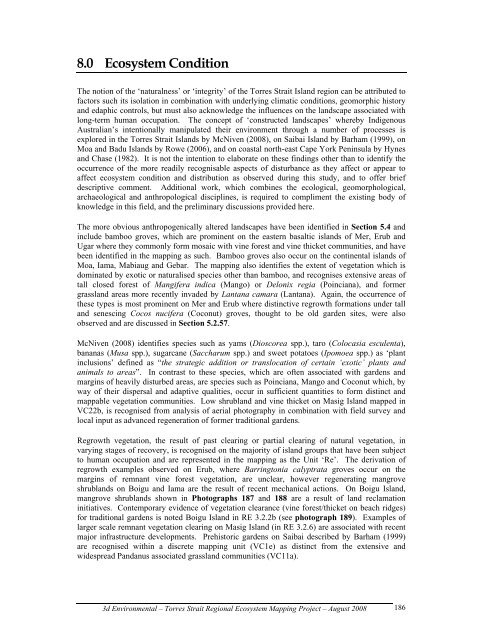Appendix 2 - Vegetation Communities and Regional Ecosystems
Appendix 2 - Vegetation Communities and Regional Ecosystems
Appendix 2 - Vegetation Communities and Regional Ecosystems
You also want an ePaper? Increase the reach of your titles
YUMPU automatically turns print PDFs into web optimized ePapers that Google loves.
8.0 Ecosystem Condition<br />
The notion of the ‘naturalness’ or ‘integrity’ of the Torres Strait Isl<strong>and</strong> region can be attributed to<br />
factors such its isolation in combination with underlying climatic conditions, geomorphic history<br />
<strong>and</strong> edaphic controls, but must also acknowledge the influences on the l<strong>and</strong>scape associated with<br />
long-term human occupation. The concept of ‘constructed l<strong>and</strong>scapes’ whereby Indigenous<br />
Australian’s intentionally manipulated their environment through a number of processes is<br />
explored in the Torres Strait Isl<strong>and</strong>s by McNiven (2008), on Saibai Isl<strong>and</strong> by Barham (1999), on<br />
Moa <strong>and</strong> Badu Isl<strong>and</strong>s by Rowe (2006), <strong>and</strong> on coastal north-east Cape York Peninsula by Hynes<br />
<strong>and</strong> Chase (1982). It is not the intention to elaborate on these findings other than to identify the<br />
occurrence of the more readily recognisable aspects of disturbance as they affect or appear to<br />
affect ecosystem condition <strong>and</strong> distribution as observed during this study, <strong>and</strong> to offer brief<br />
descriptive comment. Additional work, which combines the ecological, geomorphological,<br />
archaeological <strong>and</strong> anthropological disciplines, is required to compliment the existing body of<br />
knowledge in this field, <strong>and</strong> the preliminary discussions provided here.<br />
The more obvious anthropogenically altered l<strong>and</strong>scapes have been identified in Section 5.4 <strong>and</strong><br />
include bamboo groves, which are prominent on the eastern basaltic isl<strong>and</strong>s of Mer, Erub <strong>and</strong><br />
Ugar where they commonly form mosaic with vine forest <strong>and</strong> vine thicket communities, <strong>and</strong> have<br />
been identified in the mapping as such. Bamboo groves also occur on the continental isl<strong>and</strong>s of<br />
Moa, Iama, Mabiaug <strong>and</strong> Gebar. The mapping also identifies the extent of vegetation which is<br />
dominated by exotic or naturalised species other than bamboo, <strong>and</strong> recognises extensive areas of<br />
tall closed forest of Mangifera indica (Mango) or Delonix regia (Poinciana), <strong>and</strong> former<br />
grassl<strong>and</strong> areas more recently invaded by Lantana camara (Lantana). Again, the occurrence of<br />
these types is most prominent on Mer <strong>and</strong> Erub where distinctive regrowth formations under tall<br />
<strong>and</strong> senescing Cocos nucifera (Coconut) groves, thought to be old garden sites, were also<br />
observed <strong>and</strong> are discussed in Section 5.2.57.<br />
McNiven (2008) identifies species such as yams (Dioscorea spp.), taro (Colocasia esculenta),<br />
bananas (Musa spp.), sugarcane (Saccharum spp.) <strong>and</strong> sweet potatoes (Ipomoea spp.) as ‘plant<br />
inclusions’ defined as “the strategic addition or translocation of certain ‘exotic’ plants <strong>and</strong><br />
animals to areas”. In contrast to these species, which are often associated with gardens <strong>and</strong><br />
margins of heavily disturbed areas, are species such as Poinciana, Mango <strong>and</strong> Coconut which, by<br />
way of their dispersal <strong>and</strong> adaptive qualities, occur in sufficient quantities to form distinct <strong>and</strong><br />
mappable vegetation communities. Low shrubl<strong>and</strong> <strong>and</strong> vine thicket on Masig Isl<strong>and</strong> mapped in<br />
VC22b, is recognised from analysis of aerial photography in combination with field survey <strong>and</strong><br />
local input as advanced regeneration of former traditional gardens.<br />
Regrowth vegetation, the result of past clearing or partial clearing of natural vegetation, in<br />
varying stages of recovery, is recognised on the majority of isl<strong>and</strong> groups that have been subject<br />
to human occupation <strong>and</strong> are represented in the mapping as the Unit ‘Re’. The derivation of<br />
regrowth examples observed on Erub, where Barringtonia calyptrata groves occur on the<br />
margins of remnant vine forest vegetation, are unclear, however regenerating mangrove<br />
shrubl<strong>and</strong>s on Boigu <strong>and</strong> Iama are the result of recent mechanical actions. On Boigu Isl<strong>and</strong>,<br />
mangrove shrubl<strong>and</strong>s shown in Photographs 187 <strong>and</strong> 188 are a result of l<strong>and</strong> reclamation<br />
initiatives. Contemporary evidence of vegetation clearance (vine forest/thicket on beach ridges)<br />
for traditional gardens is noted Boigu Isl<strong>and</strong> in RE 3.2.2b (see photograph 189). Examples of<br />
larger scale remnant vegetation clearing on Masig Isl<strong>and</strong> (in RE 3.2.6) are associated with recent<br />
major infrastructure developments. Prehistoric gardens on Saibai described by Barham (1999)<br />
are recognised within a discrete mapping unit (VC1e) as distinct from the extensive <strong>and</strong><br />
widespread P<strong>and</strong>anus associated grassl<strong>and</strong> communities (VC11a).<br />
3d Environmental – Torres Strait <strong>Regional</strong> Ecosystem Mapping Project – August 2008<br />
186


